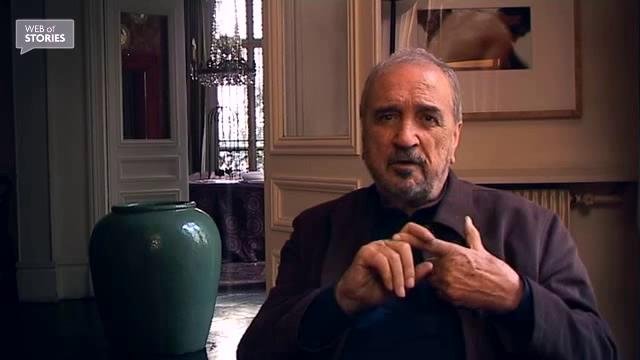NEXT STORY

Henri and Georgette
RELATED STORIES

NEXT STORY

Henri and Georgette
RELATED STORIES


|
Views | Duration | |
|---|---|---|---|
| 31. Papal assassination | 143 | 00:32 | |
| 32. Buñuel and religion | 186 | 02:43 | |
| 33. Buñuel and the Dalaï Lama | 182 | 01:50 | |
| 34. Only silence is great | 203 | 00:47 | |
| 35. My approach to Christianity | 215 | 01:57 | |
| 36. Belief is stronger than knowledge | 2 | 161 | 02:57 |
| 37. 'The Manuscript Found in Saragossa' | 193 | 01:49 | |
| 38. Working in Spain | 106 | 01:50 | |
| 39. Working with Buñuel: the daily routine | 176 | 01:47 | |
| 40. Henri and Georgette | 100 | 04:03 |


At first, Buñuel didn't write much, he didn't like his writing and I was doing all the writing work. We were working every day, three hours in the morning, three hours in the afternoon, always in my room, always face-to-face, by ourselves, improvising scenes... I can't really talk about that work as it is very personal. It all depends on whether you have a book to adapt or if you are looking for an original story. It once happened that we spent eight days together without finding anything, and then went our separate ways without having found anything. But it was always very punctual, and every afternoon we would spend half-an-hour in our rooms, we had to invent a story to tell the other in the bar – aperitif time – simply to train our imagination. Buñuel kept saying that imagination is a muscle, like memory, which needs to be trained, to keep it on the go every day, every day... otherwise our brains tend to fall back asleep and take a nap, enjoying some farniente, a thinking farniente. Our way of working was through acting, which is the same as for any director. You improvise the scenes, the ones you have been telling each other. When I watch Buñuel's films, I still see him, in front of me, acting out each character, very often the female ones. When the director takes on a character, often the main one, for example from Belle de Jour or from The Diary of a Chambermaid, it is most probably because it is a character least like him, the one that requires most effort to get close to.
D’abord Buñuel écrivait très peu, il n’aimait pas sa forme d’écriture et c’était moi qui faisais tout le travail d’écriture et nous travaillions tous les jours, trois heures le matin, trois heures après-midi, dans ma chambre et toujours face à face et toujours seuls, et en improvisant les scènes, on ne peut pas raconter ce travail là parce qu’il est très personnel, tout dépend si on a un livre à adapter ou s’il faut chercher une histoire originale. Il nous est arrivé une fois de nous rencontrer pendant huit jours et de ne rien trouver, de nous séparer sans avoir rien trouvé. Mais c’était toujours très ponctuel, et en fin d’après-midi nous passions une demi-heure seul dans nos chambres, nous avions comme obligation d’inventer chaque jour une histoire, même très brève, qu’ensuite nous nous racontions dans le bar à l’heure sacrée de l’apéritif. Et ça c’était pour entraîner l’imagination. Buñuel disait que l’imagination était un muscle comme la mémoire et qu’il faut absolument entrainer, la maintenir sur le qui-vive tous les jours, tous les jours… sinon notre cerveau à tendance à se rendormir et s’assoupir dans les délices du «farniente», farniente mental. Notre manière de travailler c’était de jouer, ça c’est la même chose avec tous les metteurs en scènes. On joue les scènes qu’on improvise, qu’on se raconte. Quand je vois les films de Buñuel, je le vois en face de moi jouant tout les personnages, très souvent les personnages féminins principales. Quand le metteur en scène prend pour lui, souvent le personnage principal, par exemple de Belle de jour ou de Le Journal d’une femme de chambre, parce que, sans doute, il est le plus éloigné de lui, c’est de lui qu’il aura le plus d’efforts à faire pour se rapprocher.
French screenwriter Jean-Claude Carrière (1931-2021) began his association with films aged 24 when he was selected by Jacques Tati to write for him. This early experience led to further contact with other film-makers, including Luis Buñuel with whom Carrière collaborated for many years. He wrote screenplays for films including Belle de Jour, The Discreet Charms of the Bourgeoisie, Tin Drum and Danton.
Title: Working with Buñuel: the daily routine
Listeners: Andrzej Wolski
Film director and documentary maker, Andrzej Wolski has made around 40 films since 1982 for French television, the BBC, TVP and other TV networks. He specializes in portraits and in historical films. Films that he has directed or written the screenplay for include Kultura, which he co-directed with Agnieszka Holland, and KOR which presents the history of the Worker’s Defence Committee as told by its members. Andrzej Wolski has received many awards for his work, including the UNESCO Grand Prix at the Festival du Film d’Art.
Tags: Luis Buñuel
Duration: 1 minute, 47 seconds
Date story recorded: January 2010
Date story went live: 27 July 2010